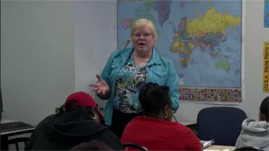Teachers' Domain - Digital Media for the Classroom and Professional Development
User: Preview



Adult education instructors Pat Marshall and Elizabeth Dinkins give learners several out-of-seat activities to illustrate and practice the concepts in the day’s lesson.
These resources are part of KET’s Teaching Strategies collection.
Differentiation in the ABE Classroom: Teacher Interview: Differentiation of Activities (Video)
Differentiation in the ABE Classroom: Teacher Interview: Choosing Activities, Part 1 (Video)
Differentiation in the ABE Classroom: Teacher Interview: Choosing Activities, Part 2 (Video)
Differentiation in the ABE Classroom: Teacher Interview: Ways to Differentiate (Video)
Differentiation in the ABE Classroom: Teacher Interview: Benefits of Differentiation (Video)
Differentiation in the ABE Classroom: Teacher Interview: Differentiation of Activities, Part I (Video)
Differentiation in the ABE Classroom: Teacher Interview: Differentiation of Activities, Part 2 (Video)
Differentiation in the ABE Classroom: Teacher Interview: Cooperative Learning (Video)
Differentiation in the ABE Classroom: Teacher Interview: Lesson Overview (Video)
"Tell me and I forget. Teach me and I remember. Involve me and I learn." Benjamin Franklin could easily have been referring to the adult education classroom when he penned these words.
Involving learners in lessons increases the potential for learning. Many learners in the adult education classroom are kinesthetic learners. They learn best by getting out of their seats and participating in the lesson.
The activities you create to complement your lessons do not need to be complicated, but it is helpful to have a variety. Differentiation of activities engages learners of various types, backgrounds, and skill levels, giving everyone the chance to participate in the classroom according to his or her own comfort level.
Differentiation also provides a level of choice in education, so allow your learners to choose one or two activities that appeal to them. Give them the option of working in teams and provide detailed instructions for each step of each activity so they know what is expected of them. Be sure to participate yourself, and have fun!
 Loading Standards
Loading Standards